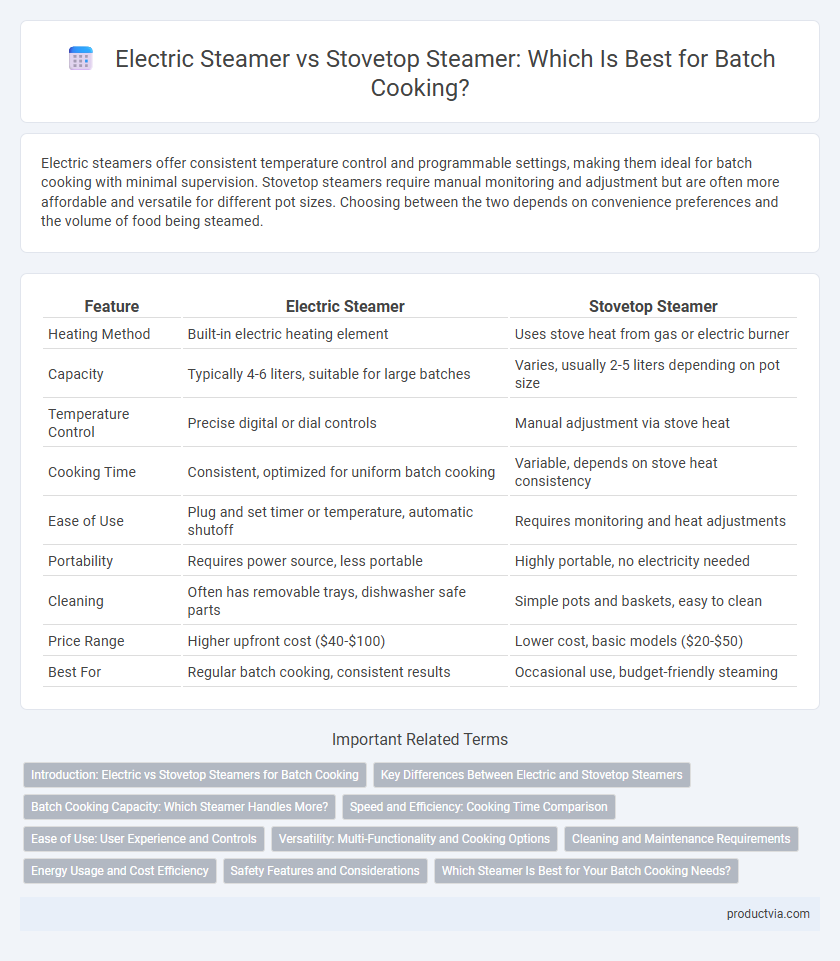Electric steamers offer consistent temperature control and programmable settings, making them ideal for batch cooking with minimal supervision. Stovetop steamers require manual monitoring and adjustment but are often more affordable and versatile for different pot sizes. Choosing between the two depends on convenience preferences and the volume of food being steamed.
Table of Comparison
| Feature | Electric Steamer | Stovetop Steamer |
|---|---|---|
| Heating Method | Built-in electric heating element | Uses stove heat from gas or electric burner |
| Capacity | Typically 4-6 liters, suitable for large batches | Varies, usually 2-5 liters depending on pot size |
| Temperature Control | Precise digital or dial controls | Manual adjustment via stove heat |
| Cooking Time | Consistent, optimized for uniform batch cooking | Variable, depends on stove heat consistency |
| Ease of Use | Plug and set timer or temperature, automatic shutoff | Requires monitoring and heat adjustments |
| Portability | Requires power source, less portable | Highly portable, no electricity needed |
| Cleaning | Often has removable trays, dishwasher safe parts | Simple pots and baskets, easy to clean |
| Price Range | Higher upfront cost ($40-$100) | Lower cost, basic models ($20-$50) |
| Best For | Regular batch cooking, consistent results | Occasional use, budget-friendly steaming |
Introduction: Electric vs Stovetop Steamers for Batch Cooking
Electric steamers offer precise temperature control and automated timing, making them ideal for consistent batch cooking with minimal supervision. Stovetop steamers provide traditional cooking methods with flexibility in pot size and heat adjustment but require more active monitoring. For large batch cooking, electric steamers enhance efficiency and ease, while stovetop options allow for customizable steaming based on stove heat and cookware used.
Key Differences Between Electric and Stovetop Steamers
Electric steamers offer precise temperature controls and timers, enabling consistent batch cooking with minimal monitoring, while stovetop steamers rely on manual heat adjustments and require more attention. Electric models typically feature multiple tiers for steaming various foods simultaneously, enhancing efficiency in large meal preparations compared to the single or limited tiers of stovetop steamers. Energy consumption varies, with electric steamers being more energy-efficient during extended use, whereas stovetop steamers depend on gas or electric stove energy sources.
Batch Cooking Capacity: Which Steamer Handles More?
Electric steamers typically offer larger batch cooking capacity with multiple tiered compartments, allowing simultaneous steaming of diverse ingredients, ideal for meal prepping. Stovetop steamers generally have a single or double-tier design limiting volume, but their size can vary depending on the pot used. For extensive batch cooking, electric steamers provide greater convenience and capacity, streamlining the preparation of large meals.
Speed and Efficiency: Cooking Time Comparison
Electric steamers typically offer faster cooking times than stovetop steamers due to their precise temperature control and built-in timers, making them ideal for batch cooking. Stovetop steamers require constant monitoring and adjustments, often resulting in longer cooking durations and less energy efficiency. Users focusing on speed and efficiency often prefer electric steamers to maximize productivity in meal preparation.
Ease of Use: User Experience and Controls
Electric steamers offer precise temperature controls and preset cooking programs, making them ideal for batch cooking with minimal supervision and consistent results. Stovetop steamers require manual heat adjustment and frequent monitoring, which can complicate multitasking during large meal preparations. The intuitive interface of electric steamers enhances user experience by simplifying operation, while stovetop models demand more hands-on skill and attention.
Versatility: Multi-Functionality and Cooking Options
Electric steamers offer enhanced versatility with programmable settings and multiple tiers, allowing simultaneous cooking of different foods at varying times and temperatures. Stovetop steamers provide customizable heat control but require manual monitoring and lack pre-set functions, limiting multi-functionality during batch cooking. For efficient batch meal preparation, electric steamers deliver superior cooking options and convenience due to their advanced features and automation.
Cleaning and Maintenance Requirements
Electric steamers typically offer easier cleaning with detachable, dishwasher-safe parts that reduce manual scrubbing time, making them ideal for frequent batch cooking. Stovetop steamers often require more effort to clean due to fixed components and potential buildup from direct heat exposure, increasing maintenance demands. Choosing an electric steamer enhances convenience and efficiency in maintaining kitchen hygiene during large meal preparations.
Energy Usage and Cost Efficiency
Electric steamers use less energy than stovetop steamers by maintaining consistent steam levels with automated temperature control, leading to lower electricity bills over time. Stovetop steamers often consume more gas or electricity due to longer heating periods and manual monitoring, increasing operational costs for large batch cooking. For cost efficiency, electric steamers deliver faster cooking times and precise energy usage, making them ideal for repeated batch cooking demands.
Safety Features and Considerations
Electric steamers for batch cooking often include built-in safety features such as automatic shut-off, boil-dry protection, and heat-resistant handles, reducing the risk of accidents. Stovetop steamers require careful monitoring to prevent water from boiling dry and pose higher risks of burns due to direct contact with the flame or hot metal surfaces. Safety considerations favor electric steamers for consistent temperature control and minimal supervision during extended cooking periods.
Which Steamer Is Best for Your Batch Cooking Needs?
Electric steamers offer precise temperature control and larger capacity, making them ideal for batch cooking with consistent results and minimal supervision. Stovetop steamers require more hands-on attention and may have smaller capacity but provide flexibility on any heat source without reliance on electricity. For optimal batch cooking, choose an electric steamer for efficiency and volume, while stovetop steamers suit kitchens prioritizing versatility and traditional cooking methods.
Electric steamer vs Stovetop steamer for batch cooking Infographic

 productvia.com
productvia.com